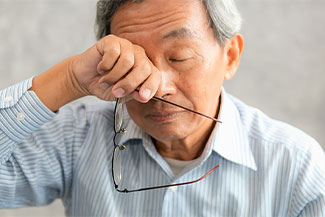
Can Macular Degeneration Be Treated?
Macular degeneration is the deterioration of the macula, the central part of the retina — the internal back layer of the eye that receives the light rays of the images we see, and sends them via the optic nerve from the eye to the brain.
The macula is responsible for our clear, crisp vision. Early diagnosis and treatment are critical to preventing vision loss and maintaining your independence and quality of life.
Age-Related Macular Degeneration (AMD)
There are two main kinds of AMD, dry and wet. Dry AMD is the most commonly diagnosed type, accounting for 90% of cases. Wet AMD, which represents about 10% of AMD cases, usually starts off as dry AMD. Although the wet type is less common, its consequences are far more devastating, resulting in 90% of the legal blindness caused by AMD.
It is possible for dry AMD to advance and cause loss of vision without turning into wet AMD. However, it is also possible for early-stage dry AMD to suddenly change into wet AMD.
AMD tends to occur more frequently with age. About 0.4% of people between 50 and 60 have the disease, while it occurs in 0.7% of people 60 to 70; 2.3% of those 70 to 80, and nearly 12% of people over 80 years old.
In dry macular degeneration, the deterioration of the retina is associated with the formation of small yellow deposits, known as drusen, under the macula. This phenomenon leads to a thinning and death of the retinal cells, causing the macula to lose its function. The amount of central vision loss is directly related to the location and amount of retinal thinning, but generally happens slowly over many years.
As AMD worsens, the light-sensitive cells in your macula further deteriorate and eventually die, causing permanent vision loss.
Wet AMD occurs when new, extremely fragile blood vessels leak fluid and blood into the macula. The pooling of fluid and blood can create a sudden and extreme loss of vision, including visual distortions, blurry vision, and eventually blindness.
 Dry AMD Treatment
Dry AMD Treatment
While there is currently no treatment for dry AMD, people with significant levels of drusen or vision loss might benefit from taking a certain combination of nutritional supplements.
The most commonly prescribed treatment for dry AMD is nutritional therapy, with a healthy diet high in antioxidants to support the cells of the macula. AREDS and AREDS2 formulas are nutritional supplements that have been clinically proven to reduce the risk of progressing from the mild stage to advanced AMD.
The AREDS and AREDS2 formulas are combinations of a high-dose of daily vitamins and minerals including vitamins C and E, lutein, zeaxanthin, zinc, and copper. These nutritional supplements come in a range of commercially available options. They won’t prevent or cure AMD, but they may slow it down.
If you have dry AMD, ask your eye doctor whether these vitamins and minerals could benefit you.
Wet AMD Treatment
Wet AMD occurs when a protein called vascular endothelial growth factor (VEGF) causes an overabundance of leaky new blood vessels to grow in the retina. The body releases the VEGF proteins to combat the impact of AMD, but these new blood vessels can cause more harm than good.
There are 3 treatment options that may slow down or prevent vision loss from wet AMD:
Anti-VEGF Injections
Even if you have already noticed decreased vision, these injections can possibly restore some of your lost sight. They absorb the leaked fluid and blood, and can stop further bleeding and leaking from blood vessels in the back of your eye.
After receiving these injections some patients immediately enjoy clearer vision because the pooling of fluid and blood in the macula has diminished.
The procedure involves the injection of anti-VEGF medicine into your eye with a very small needle. After the treatment, you may need to use antibiotic eye drops to keep your eyes from becoming infected. Anti-VEGF injections usually only work for a short time — weeks or months — so most people receive several such injections over the years.
Photodynamic Therapy (PDT)
Photodynamic therapy is a laser surgery that treats some types of wet AMD, and uses a drug called Visudyne. PDT is a two-step procedure that can be performed in a doctor’s office. First, Visudyne is injected intravenously into the patient’s arm. The drug is then activated by shining a non-thermal laser light into the patient’s eye. The procedure seals off leaking vessels while leaving healthy ones intact, and is considered a major improvement over previous laser treatments.
PDT is usually used as a second treatment along with anti-VEGF injections. The laser surgery will not restore any vision loss, but its effects last longer. Some people will need to repeat the treatments.
Laser Photocoagulation
Until recently, laser photocoagulation was the only available laser treatment to seal leaking blood vessels associated with wet AMD. Nowadays, the procedures above have largely replaced this option. In this procedure, the laser is used to permanently destroy retinal tissue associated with the new blood vessels. This option can be effective in preventing new vessels from growing and leaking, but can also cause unwanted side-effects such as black spots and distorted vision.
Laser photocoagulation is still an important part of the eye doctor’s toolkit, especially to treat advancing wet AMD.
If you have vision loss from wet AMD, ask your eye doctor if either of these treatments can help you.
Visiting your eye doctor regularly and having a comprehensive eye examination can help detect AMD in its early stages. While there is currently no cure for AMD, treatment may slow the disease and keep you from having severe vision loss and may able to restore some loss of sight. Contact Dr. Marcy Rose to find the best treatment plan and ways to manage your AMD.
Our practice serves patients from Westminster, Broomfield, Thornton, and the Front Range, Colorado and surrounding communities.








